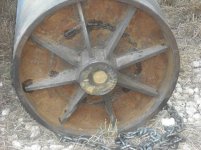alphonso
Titanium
- Joined
- Feb 15, 2006
- Location
- Republic of Texas
Need to find a lathe that will clear 24" + diameter over cross slide and 200" + between centers. Prefer Texas and surrounding states.
Follow along with the video below to see how to install our site as a web app on your home screen.
Note: This feature may not be available in some browsers.

I'm wondering what the job is?
Could do the job on a boring mill.
15.5 foot by 24 inch dia. truss press rollers with 4inch dia. shafts sticking out 9 inches on each end. Broke off shaft on one end.
If I understand correctly, you don't need 24" swing over the cross slide, as it should be to the right of the 24" roll when everything is set up. Or am I missing something?
You will need at least one, and maybe two steady rests of sufficient size, so may need a bigger lathe for that aspect alone.
Going to bore out the end and press/shrink in a new stub?

Do not weld to the shaft at the outer bulkhead, it will break as shown. Instead,make a spacer, say 6 od, snug slip on shaft, 1 long. Weld that spacer to the outer bulkhead with the shaft properly installed. The shrink from welding will shrink the spacer for a tremendous grip. The shrink will still make a stress riser, but not nearly as much as the riser at the toe of a weld.
I don't think you'll have to worry about turning the OD if you are running it in a steady. It will still take a good-sized lathe to reach in there to make a clean spot to weld in the new bulkhead. I think I would cut the old bulkhead out and put the new bulkhead slightly to the outside so I didn't have to clean up the previous welded area.
Are a pair of these rollers used to press the crimp plates on trusses?
Alphonso,Need to find a lathe that will clear 24" + diameter over cross slide and 200" + between centers. Prefer Texas and surrounding states.
Yes, to press the crimp plates on trusses. Gantry travels along the table that the trusses are laid out on. Only one roller per machine. I think the newer style runs the truss thru two rollers like an old washing machine wringer. Manual for new style press: Alpine Equipment Manuals - RollerPress Product Manual The adjustment procedure( pages 15 - 16) illustrates to me the piss poor design of the machine.
The shaft didn't break at the weld, it broke where it is turned down for the bearing. No fillet, even though drawing shows one.
Considering leaving enough of the existing inner bulk head in place and bolting a new one to it. Maybe do the same for outer one, too.
IIRC the Lincoln book "Design of Weldments" addressed this pretty good. I think there where some examples of rollers built just like that you are trying to doo.
Notice
This website or its third-party tools process personal data (e.g. browsing data or IP addresses) and use cookies or other identifiers, which are necessary for its functioning and required to achieve the purposes illustrated in the cookie policy. To learn more, please refer to the cookie policy. In case of sale of your personal information, you may opt out by sending us an email via our Contact Us page. To find out more about the categories of personal information collected and the purposes for which such information will be used, please refer to our privacy policy. You accept the use of cookies or other identifiers by closing or dismissing this notice, by scrolling this page, by clicking a link or button or by continuing to browse otherwise.
